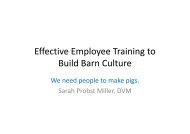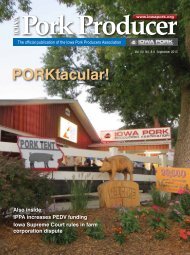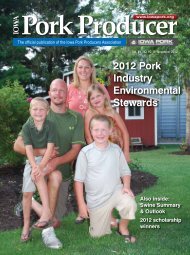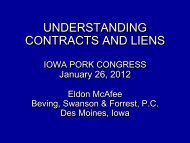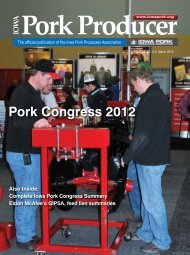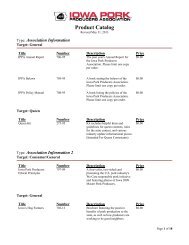September 2011 - Iowa Pork Producers Association
September 2011 - Iowa Pork Producers Association
September 2011 - Iowa Pork Producers Association
Create successful ePaper yourself
Turn your PDF publications into a flip-book with our unique Google optimized e-Paper software.
News from the<br />
National <strong>Pork</strong> <strong>Producers</strong> Council<br />
Pew Comission report urges restrictions<br />
on livestock numbers<br />
An environmental group is calling on the U.S.<br />
Environmental Protection Agency to use controls<br />
put in place to enforce total maximum daily limits on<br />
certain nutrients going into the Chesapeake Bay to<br />
impose livestock and poultry density limits.<br />
In a July 27 report, “Big Chicken: Pollution and<br />
Industrial Poultry Production in America,” the<br />
Pew Environment Group – not to be confused with<br />
the Pew Commission on Industrial Farm Animal<br />
Production, but which includes personnel from that<br />
commission – urged EPA to depopulate or limit<br />
livestock and poultry farms through Clean Water Act<br />
permits the facilities would be required to obtain.<br />
The Pew report also calls on EPA to set standards for<br />
land-application of manure and urges states in the<br />
Chesapeake Bay to require large and medium-sized<br />
livestock and poultry facilities to obtain permits. But<br />
in a recent lawsuit NPPC filed and won, a federal court<br />
rejected an EPA rule that sought to require CAFOs<br />
that “propose” to discharge to seek permits. The court<br />
ruled that only facilities that actually discharge must<br />
obtain permits.<br />
Comments submitted on draft<br />
guidance on identifying waters<br />
protected by CWA<br />
NPPC in July joined a number of other organizations<br />
submitting comments on draft guidance on<br />
identifying waters protected by the Clean Water Act.<br />
NPPC and the other organizations expressed concern<br />
with that expansion, commenting that the agencies<br />
misconstrued and reinterpreted a U.S. Supreme<br />
Court case to support their new, expansive definition<br />
of “waters of the United States.” In addition, the<br />
groups said the scope of the guidance and its call for<br />
modifications to existing EPA and Corps rules make it<br />
a proposed regulation, which should be promulgated<br />
under the rules of the Administrative Procedures Act.<br />
Federal welfare law on egg production<br />
a dangerous precedent<br />
The National <strong>Pork</strong> <strong>Producers</strong> Council has expressed<br />
concern that federal legislation being pushed by the<br />
Humane Society of the United States (HSUS) and the<br />
United Egg <strong>Producers</strong> (UEP) would set a dangerous<br />
precedent for allowing the federal government to<br />
dictate how livestock and poultry producers raise and<br />
care for their animals.<br />
The proposal would inject the federal government into<br />
the marketplace with no measureable benefit to public<br />
or animal health and welfare, NPPC said.<br />
HSUS and UEP announced an agreement between the<br />
two organizations July 7 on the size of cages for laying<br />
hens, moving from UEP’s standard of 64 square inches<br />
to 124 square inches over 15-18 years. HSUS agreed to<br />
stop litigation against<br />
and undercover<br />
Proposed by the U.S. Environmental Protection<br />
Agency and the U.S. Army Corps of Engineers, the<br />
draft guidance would expand the agencies’ jurisdiction<br />
over waterways and bodies of water.<br />
36 SEPTEMBER <strong>2011</strong>




